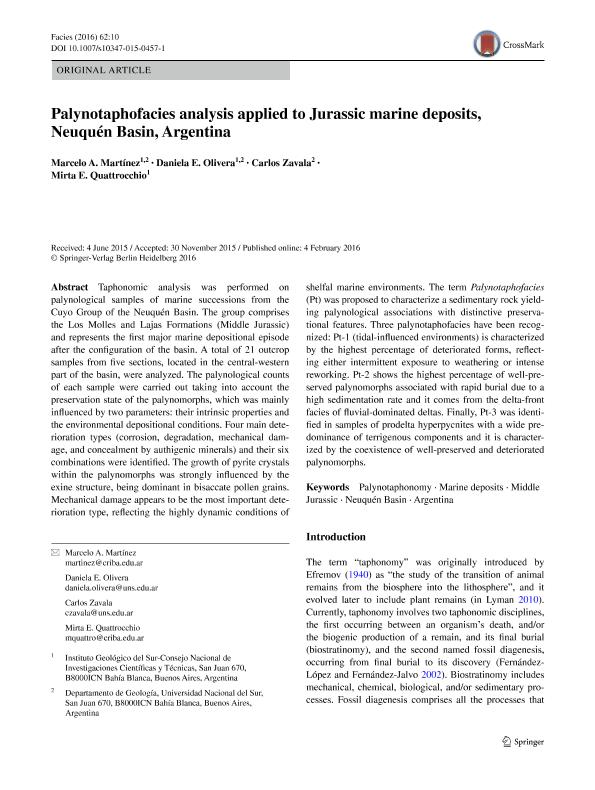Mostrar el registro sencillo del ítem
dc.contributor.author
Martinez, Marcelo Adrian

dc.contributor.author
Olivera, Daniela Elizabeth

dc.contributor.author
Zavala, Carlos Alberto

dc.contributor.author
Quattrocchio, Mirta Elena

dc.date.available
2018-09-07T22:22:17Z
dc.date.issued
2016-04
dc.identifier.citation
Martinez, Marcelo Adrian; Olivera, Daniela Elizabeth; Zavala, Carlos Alberto; Quattrocchio, Mirta Elena; Palynotaphofacies analysis applied to Jurassic marine deposits, Neuquén Basin, Argentina; Springer; Facies; 62; 2; 4-2016; 1-16
dc.identifier.issn
0172-9179
dc.identifier.uri
http://hdl.handle.net/11336/58865
dc.description.abstract
Taphonomic analysis was performed on palynological samples of marine successions from the Cuyo Group of the Neuquén Basin. The group comprises the Los Molles and Lajas Formations (Middle Jurassic) and represents the first major marine depositional episode after the configuration of the basin. A total of 21 outcrop samples from five sections, located in the central-western part of the basin, were analyzed. The palynological counts of each sample were carried out taking into account the preservation state of the palynomorphs, which was mainly influenced by two parameters: their intrinsic properties and the environmental depositional conditions. Four main deterioration types (corrosion, degradation, mechanical damage, and concealment by authigenic minerals) and their six combinations were identified. The growth of pyrite crystals within the palynomorphs was strongly influenced by the exine structure, being dominant in bisaccate pollen grains. Mechanical damage appears to be the most important deterioration type, reflecting the highly dynamic conditions of shelfal marine environments. The term Palynotaphofacies (Pt) was proposed to characterize a sedimentary rock yielding palynological associations with distinctive preservational features. Three palynotaphofacies have been recognized: Pt-1 (tidal-influenced environments) is characterized by the highest percentage of deteriorated forms, reflecting either intermittent exposure to weathering or intense reworking. Pt-2 shows the highest percentage of well-preserved palynomorphs associated with rapid burial due to a high sedimentation rate and it comes from the delta-front facies of fluvial-dominated deltas. Finally, Pt-3 was identified in samples of prodelta hyperpycnites with a wide predominance of terrigenous components and it is characterized by the coexistence of well-preserved and deteriorated palynomorphs.
dc.format
application/pdf
dc.language.iso
eng
dc.publisher
Springer

dc.rights
info:eu-repo/semantics/openAccess
dc.rights.uri
https://creativecommons.org/licenses/by-nc-sa/2.5/ar/
dc.subject
Argentina
dc.subject
Marine Deposits
dc.subject
Middle Jurassic
dc.subject
Neuquén Basin
dc.subject
Palynotaphonomy
dc.subject.classification
Meteorología y Ciencias Atmosféricas

dc.subject.classification
Ciencias de la Tierra y relacionadas con el Medio Ambiente

dc.subject.classification
CIENCIAS NATURALES Y EXACTAS

dc.title
Palynotaphofacies analysis applied to Jurassic marine deposits, Neuquén Basin, Argentina
dc.type
info:eu-repo/semantics/article
dc.type
info:ar-repo/semantics/artículo
dc.type
info:eu-repo/semantics/publishedVersion
dc.date.updated
2018-09-04T16:52:57Z
dc.journal.volume
62
dc.journal.number
2
dc.journal.pagination
1-16
dc.journal.pais
Alemania

dc.journal.ciudad
Berlín
dc.description.fil
Fil: Martinez, Marcelo Adrian. Consejo Nacional de Investigaciones Científicas y Técnicas. Centro Científico Tecnológico Conicet - Bahía Blanca. Instituto Geológico del Sur. Universidad Nacional del Sur. Departamento de Geología. Instituto Geológico del Sur; Argentina
dc.description.fil
Fil: Olivera, Daniela Elizabeth. Consejo Nacional de Investigaciones Científicas y Técnicas. Centro Científico Tecnológico Conicet - Bahía Blanca. Instituto Geológico del Sur. Universidad Nacional del Sur. Departamento de Geología. Instituto Geológico del Sur; Argentina
dc.description.fil
Fil: Zavala, Carlos Alberto. Consejo Nacional de Investigaciones Científicas y Técnicas; Argentina. Universidad Nacional del Sur. Departamento de Geología; Argentina
dc.description.fil
Fil: Quattrocchio, Mirta Elena. Consejo Nacional de Investigaciones Científicas y Técnicas. Centro Científico Tecnológico Conicet - Bahía Blanca. Instituto Geológico del Sur. Universidad Nacional del Sur. Departamento de Geología. Instituto Geológico del Sur; Argentina
dc.journal.title
Facies

dc.relation.alternativeid
info:eu-repo/semantics/altIdentifier/url/https://link.springer.com/article/10.1007/s10347-015-0457-1
dc.relation.alternativeid
info:eu-repo/semantics/altIdentifier/doi/http://dx.doi.org/10.1007/s10347-015-0457-1
Archivos asociados
